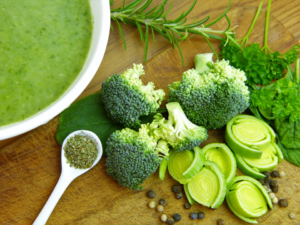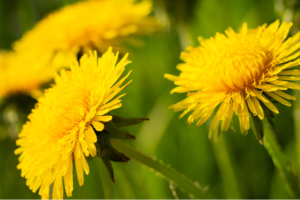
A spring cleanse with diet and herbs
It’s time for some Spring cleaning, using herbs and diet to help the body’s own elimination process.
Healing sunlight
March has arrived and for us in Cornwall this means we have an extra 4 to 5 hours of daylight compared to midwinter. Extra light and warmth means more opportunities to have some sunlight on our skin ¹. This triggers the production by the skin of a precursor to Vitamin D which is converted into active Vitamin D by the liver and kidneys. Exposing just your arms for 30 minutes each day from April to September will provide healthy levels of Vitamin D and will enable some to be stored in our fat cells for up to a month. Getting some morning light on your face is a good practice because daylight entering the eyes ² especially in the morning, triggers photosensitive cells in the retina. This begins a cascade of effects which includes resetting circadian rhythms, lowering inflammation, improving healing of tissues and helping to remove toxins from the body.
Time for change
The extra daylight and the feeling of wellbeing that it generates makes Spring an ideal time to improve the body’s detoxification processes. Unfortunately in the modern world we are all exposed to a variety of toxic substances such as air pollutants, pesticides, allergens and bowel toxins. Our liver deals with these naturally, changing the toxic substances into a form that can be eliminated via the bowels and kidneys. However, even the healthiest liver can benefit from some support in the form of reducing exposure and a cleaner lighter diet and some herbal tonics.
Toxic burden
First of all, reduce your exposure to toxins. Try to spend more time in a clean environment, away from road traffic for example. Think about the products you use in the home, some of them may contain toxic substances like formaldehyde a powerful irritant, or phthalates which can harm the reproductive system. Instead, use natural cleaning products and cosmetics.

Food wise – if you can, eat organic or at least avoid the produce most likely to contain pesticides such as spinach, kale , apples and peppers. (See The dirty dozen and the clean fifteen at www.pan-uk.org/dirty-dozen/)
A lighter diet
If you wish to try a spring cleansing diet regime I find it’s best to step down gradually from winter comfort eating into a short period of a light vegetable rich diet ³ and then step back up again but this time to a diet that is healthy and nourishing for you. For example:
Step 1: Eliminate coffee, alcohol and other stimulants. Increase fluid intake (water and herb teas). Eat organic where possible. Eliminate polyunsaturated oils and fats. Cook in water or coconut oil. Don’t heat olive oil but add it after cooking for flavour or to salads.
Step 2: As step 1 plus eliminate sugar and fruit juice, red meat and wheat. Reduce dairy.
Step 3: (For 2 or 3 days only) As above plus reduce carbohydrates, switch from root veggies to leafy ones such as spinach and kale, add in celery and onions. Include red and purple berries. Drink water and herb teas.

Step 4: Gradually reintroduce the foods that you enjoy, while focusing on adequate protein, healthy fats (coconut oil, butter, ghee and olive oil) and moderate carbohydrates. It’s really important to continue with plenty of veggies, herbs and spices – as many colours flavours and textures as possible. Many people find they feel better on a wheat free diet – eating sweet potatoes, potatoes, rice and oats instead.
If you prefer not to try a spring cleanse diet, you can still provide your liver and digestive system with a wonderful tonic in the form of herbal medicine.
A herbal liver tonic
Dandelion (Taraxacum officinale) is a valuable tonic for liver and kidneys. If you have a garden and it’s chemical free, you can dig up some roots. Be sure to identify the correct plant. You’ll need about 2 tablespoons of the chopped dandelion root, cover with water and simmer for ten minutes. Strain and drink. Even better is to add the chopped root to a soup or stew because by taking in the whole plant you have the benefit of inulin and fibre – perfect food for the digestive microbiome and the liver. Half a tablespoon of dandelion root per portion is enough. Use the leaf too – chopped and made into a tea. Use 1 dessert spoonful per 250ml of boiling water. Steep for 5 minutes, strain and drink for a gentle kidney tonic. ⁴

In my herbal practice I offer many herbs to support the liver and digestive system, some of these are more potent and active than dandelion for example Schisandra, Milk thistle and herbs containing bitter antimicrobial compounds like berberine and artemisinin These are useful for people with liver and digestive problems. I typically prescribe a mixture of 3 – 6 herbs depending on the individual’s health condition and constitution, always with safety in mind. If you want to have a chat about your health issues and how herbal medicine could help, please book your free initial call through The Wellness Hub or contact Carol at cornwallherbalclinic@hotmail.com
Notes
- Limit exposure, start with just a few minutes each day and cover up before any risk of burning. Take extra care with children and elderly people.
- Between 8 and 10am is best. Never look directly at the sun due to a risk of retinal damage.
- This is not intended to replace medical advice e.g. if you have allergies or require a special diet please seek advice from your health care practitioner.
- Dandelion is rich in potassium so may not be suitable for anyone on a low potassium diet.
